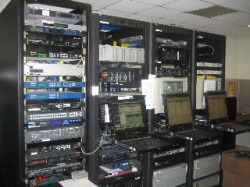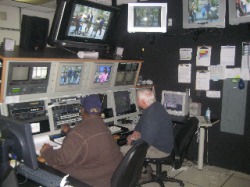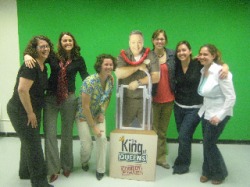Social Construction Awareness
Planning the Field Trip:
At our first meeting our media social issues group wanted to try to plan a field trip to either a television station or a newspaper place to get an inside look at how the media reaches the public. We decided to first try Wisconsin Public Television located in Vilas Hall because of its location and how it seemed so independently aligned. We contacted two people there but because of scheduling and the digital switchover coming up they could not fit a tour in for another three to four weeks. Next, we called WKOW, which is a larger, more mainstream station in the local area but the scheduling person was out of the office. The same thing happened at NBC15 so I tried calling the CW. The CW is a smaller more corporate station that is located off of Fish Hatchery Rd. We contacted Chris who sets up tours and they were willing to have our group of five come in whenever worked for us. Chris informed me that their station does not do media production but they have a media switchboard, a green-screen and are willing to answer any questions we may have. We set up a field trip for five at no cost and they could get us in the next day if we needed. We were going to see how media is distributed to the public and the process it goes through.
Resources:
Wisconsin Public Radio 263-2121 821 University Ave
WKOW27 274-1234 5727 Tokay Blvd
NBC15 274-1515 615 Forward Dr.
WBUW(cw) 270-5700 2814 Syene Rd.
CW Field Trip

The "Control Station"
CW Field Trip

Working hard or hardly working? Just kidding, these men were hard at work making sure the sound matched up with the images on the screen. Someone has to watch these screens 24 hours a day, 7 days a week.
CW Field Trip

Here is our group posing with Emmy Fink, the CW's local personality herself, and Mr. Doug Heffernan. Good people, good people.
Holly's Reflection
We visited Madison's CW for our Social Issues Group Field Trip. Our field trip included a tour of the station and meeting the small staff that makes this channel possible. We were on this field trip for about an hour and a half. We had a tour of the whole station and talked with each person on staff. We were first introduced to the station owner who welcomed us to the CW and began to explain how advertising is done at such a small network. It was interesting to learn that this station stays afloat because of specific advertisers that want to have their commercial played during the most popular programs. The owner was interested to know if we have ever seen any of the programs on the CW and if so, which ones. We each explained what we watched and he asked many questions about it. He also explained how the new HD shift has affected his station. He wondered how clear the station was for each of us. It was interesting because I do not have cable and this station (15) is the only station that comes in completely clear in my apartment, he was very happy to learn this.
Next, the CW's television personality, Emmy Fink showed us around the station. She discussed that they are trying to promote positive segments from around the community, instead of showing all of the negativity that other stations have to report. This is called the "Daily Buzz." It was interesting to hear about this segment, because I see it advertised all of the time, but have never seen a whole segment. They are also taking the "Daily Buzz" to many local schools to promote reading and positive environments to the community. This is a great community builder that many networks cannot provide. I think the CW is doing a great job of building community and this aspect shows students that we all need to work towards making positive differences in our community.
The CW showed how a small station can really make a difference, however at the time I was not aware that they did not have a news program anymore. I would have liked to ask news reporters questions because my unit is about the news. The station owner informed us that they use to have a short news report but did not have a large enough audience to continue. I think it would still be beneficial to take a class for a field trip here because we still had the opportunity to see the cameras, greenrooms and where a news report use to take place. We also saw how a clip is edited and how voice-overs work in commercials and other advertising segments. This is a safe environment that students could feel comfortable asking questions in. On a school field trip the owner said they usually get the microphones out and the students pretend to be reporters, which fits in with my unit perfectly. I would definitely consider bringing a class on a field trip to the CW. Everyone was extremely friendly and welcoming, this would be a great atmosphere for a class of third graders or forth graders. It also wouldn’t be too overwhelming for a class since it is a smaller scale network, but it gives students the opportunity to get a better understanding of a media network.
Lyndsay's Reflection
Fieldtrip to the CW!
I am part of the media social issues group and we decided to plan and take a trip to the local CW television station to learn more about how media is produced, sold and exported into people’s homes. This fieldtrip was a great learning experience and would be a great trip for a future class of mine to take when studying advertising in the media and how it is sold and run on tv.
We began our hour and a half long field trip by meeting with the CW manager at the station. He was very personable and interested in our feedback on his station. He asked us about the programs we watch and what our favorites were. He then told us about how television ratings work. Surveys are sent out in the mail or collected by telephone by a neutral company that collects these surveys and determines popular viewing times and programs. Although the sample size and demographic of the returning surveys do not necessarily accurately portray the actual viewers of the station, the ratings are calculated by the company and then released to television and other media stations as well as to advertising companies. Based on these quarterly reviews, shows are scheduled at each television stations based on the popularity of the show and popular viewing times. At the CW, shows are sent to the CW with blocks of time cut out of them for commercial breaks and the manager then takes the showtime schedule derived from the ratings scale and works with advertisers to schedule in 90 second to three minute commercial blocks. Most commercials are 30 seconds long, some are 15 and others are up to a minute but based on the amount of time, the popularity of the show that is being viewed by station viewers, and the time of day the advertising company wants to run their ads the station charges a specific rate to these advertisers to run their ads. For example, a local pet store may choose to run their ads during a soap opera in the middle of the day so that their ads are seen by stay at home moms and the prices will not be as high as prime time shows with younger audiences or during Saturday morning cartoon time to get kids to want to visit their store with their parents. During the SuperBowl, advertisers pay millions of dollars for their ads to be run for just 30 seconds because the game is one of the most highly viewed programs the entire year.
After learning a little about how advertising works, our group had the opportunity to meet with a few different employees of the small CW station. We first saw how commercials are created and how they go through the shoot, back to the station to be edited and have special effects added and finalized. We got to see a few local commercials that the editor had just created. Next, we moved on to see how voice-overs and program editing are done at the CW by their very own Emmy Fink, a local celebrity who has her own segment on “The Daily Buzz” show which promotes only local, positive news. It was really cool to see these huge computers and switchboards that are used to create these mini-shows and the staff was willing to answer any questions we had.
After these two stops, our group headed into the main control room which was crawling with wires upon wires that were all bundled together, all of which transmit tv signals from the station to the tower across the beltline whose signal reaches throughout and a bit beyond Dane County. There was one man we met whose job it was to sit in front of seven or eight television monitors just to make sure that the lips of the people moving matched up with their voices. Someone has to sit there 24 hours a day, seven days a week. That was his job!! The last stop we made on our fieldtrip was to the room with the huge green screen where the news station used to be, but the local news is no longer produced there because there was a lack of an audience. We took a few pictures with Emmy Fink, asked a few final questions and left the behind-the-scenes look into what goes on at a television station.
This fieldtrip would be very appropriate for a second or third grade class learning about media. The CW station in particular is small but full of media wonders that students could really benefit from and Emmy Fink told us that students could even learn how to use the green screen like they were on tv. Overall, this fieldtrip was a success and I would recommend a visit to the CW to any teacher and class interested in learning more about different aspects of media production, editing and delivery.
Molly's Reflection
As a member of the Media and Social Issues group, we decided to take a field trip to Madison's CW Television Station to learn more about how a television station operates. We toured the station and learned about the advertising that occurs between shows, why shows are shown at certain times and how the ratings highly influence those times, interviewing, how shows are produced and we were shown a media room where all of the shows are monitored.
We started our hour and a half tour by talking to the manager of the CW. He was able to talk to us about the television shows they choose to air, why they choose those shows and how they determine what commercials to run during the shows. He was very interested in what shows we watch and why. After we discussed what our favorite shows were, he started to talk about the ratings and how they can greatly affect if and when a show is shown on the CW. He commented on the target age range and how it is important to know what age range watches each show because then they will be able to entice the audience with appropriate commercials. I asked him how ratings were collected and he told us that in the Madison area, it is done randomly sampling households in the listening area. He commented that this is not the most efficient way because sometimes parents are the only ones that fill these forms out so the children's viewing choices are not considered. The manager said the best way for ratings to be collected is by using a device that can tell how many households are tuned into a show at one time. This is how they obtain rating information in the Milwaukee area and the manager hopes that this technology will be brought to Madison.
Our next stop was to visit Big Mike in the production room. He is in charge of filming and editing any show that is produced by the CW, like the Daily Buzz. We learned editing can be a long process because there is a wait period that happens every time you are transferring files from one audio device to another. Big Mike said a lot of his time is spent waiting for the transfers to occur. We also stopped in and talked to Dan who handles scripting, filming, editing and producing all of the local commercials that are shown during the shows. I thought he had one of the most interesting jobs because he was responsible for producing an entire commercial and he could use his creativity to make each commercial unique.
We also visited the control room. This room had so many wires coming from every direction but each wire is essential because if there is a problem, the sound and image being shown to the home viewers won't match up. We found out that someone has to be in that room to monitor the shows 24 hours a day, 7 days a week!
Our last stop of the day was in the green screen room to take our picture. Emmy Fink, the reporter for the Daily Buzz, talked to us about what her role is at the CW. She explained that members from the Madison community will e-mail or call in with some interesting news and then she will get the opportunity to interview community members to find out more about this cause. I asked if she has to do research before she goes to these interviews and she told us that she tries her best but sometimes there isn't enough time so you always have to be thinking on your feet.
I think this would be a great place to take my students as we learn about current events and how news is produced and sent out to the world. Emmy mentioned when students come for a tour, they are able to shoot some clips, watch them be edited and aired later that night. I think this is an amazing opportunity for all students and I would highly recommend Madison's CW as a field trip destination.
Stacy's Reflection
When we went on this field trip, I was trying to keep in mind how I could tie in this particular field trip, or any information I learned. I learned a decent amount about how advertising can sometimes come from the national broadcasters, and how certain spots are left open when sent down from the national station for local companies to buy for local advertising. I also went in with a general idea that different spots cost different amount for advertisers, but I did not know the specific details. I feel much more informed as far as commercials go after this field trip, but I do not know if I would take my students on the exact same tour I took. I feel that it seems cool, but it was a lot of direct lecturing and not very much demonstration or concrete examples, so it could be difficult to keep a group of 20 students focused. Perhaps I could work with the station to plan something a little more student-friendly, including some more active learning. One of the tour guides mentioned that they would be able to allow students to record their own voices as voice-overs for commercials; if we could come up with more activities like that, I feel it would be a much more valuable experience for my students. It could also make any activities we do in the classroom more relevant to their prior experiences in the newsroom.
Sunshine's Reflection
I was really surprised at how small Madison's CW television station was. The owner was very warm and welcoming, and he seemed happy to give us his time. He spoke a lot about the science behind advertising, such as understanding the interests and spending habits of the particular audience type that views a program. He spoke fast and about a lot of technical stuff, but he was happy to answer any of our questions.
We chose a television site because media is the central focus of most of our unit plans. Personally, my unit is on social construction and a little more removed from the topic of media, but I still found this trip relevant to my subject area. I had an opportunity to talk to one of the advertising associates about his views on how advertising influences the local community and what moral responsibilities people in his position have to the community. It was an interesting conversation, and I learned that most of the trend-setting that happens in advertising is controlled at the national and international levels.
I might take children on a field trip to a station such as this one in the future. Although it was small, we received a lot of personalized attention and it made TV seem more real (rather than some mysterious universal power). I know that I watched channel 2 in a new way after taking the tour!
